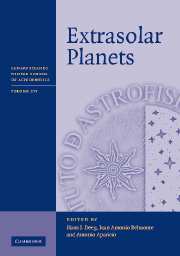Book contents
- Frontmatter
- Contents
- List of contributors
- List of participants
- Preface
- Acknowledgements
- 1 Overview of extrasolar planet detection methods
- 2 Statistical properties of exoplanets
- 3 Characterizing extrasolar planets
- 4 From clouds to planet systems: formation and evolution of stars and planets
- 5 Abundances in stars with planetary systems
- 6 Brown dwarfs: the bridge between stars and planets
- 7 The perspective: a panorama of the Solar System
- 8 Habitable planets around the Sun and other stars
- 9 Biomarkers of extrasolar planets and their observability
- References
5 - Abundances in stars with planetary systems
Published online by Cambridge University Press: 10 August 2009
- Frontmatter
- Contents
- List of contributors
- List of participants
- Preface
- Acknowledgements
- 1 Overview of extrasolar planet detection methods
- 2 Statistical properties of exoplanets
- 3 Characterizing extrasolar planets
- 4 From clouds to planet systems: formation and evolution of stars and planets
- 5 Abundances in stars with planetary systems
- 6 Brown dwarfs: the bridge between stars and planets
- 7 The perspective: a panorama of the Solar System
- 8 Habitable planets around the Sun and other stars
- 9 Biomarkers of extrasolar planets and their observability
- References
Summary
Extensive spectroscopic studies of stars with and without planetary systems have concluded that planet host stars are more metal-rich than those without detectable planets. More subtle trends of different chemical elements begin to appear as the number of detected extrasolar planetary systems continues to grow. I review our current knowledge concerning the observed abundance trends of light and heavy elements in planet host stars and their possible implications. These studies may help us to understand the chemical evolution of our Galaxy at supersolar metallicities.
Introduction
Beginning with the discovery by Mayor & Queloz (1995) of a giant planet, 51 Pegasi b, the number of planets orbiting solar-type stars has now reached 137. Most of the planets have been discovered by the Geneva and California & Carnegie groups using a Doppler technique. This sample size is now sufficient to search for various statistical trends linking the properties of planetary systems and those of their parent stars. It has been suggested that one of the key factors relevant to the mechanisms of planetary system formation is the metallicity of protoplanetary matter (Pollack et al. 1996). Note that in the context of this paper we consider as ‘metals’ all elements except H, He, Li, Be and B.
Chemical abundance studies of planet hosts are based on high signal-to-noise (S/N) and high resolution spectra. Many targets have been observed by more than one group, allowing useful crosschecks of their analyses and spectra.
- Type
- Chapter
- Information
- Extrasolar Planets , pp. 150 - 161Publisher: Cambridge University PressPrint publication year: 2007
References
- 21
- Cited by

